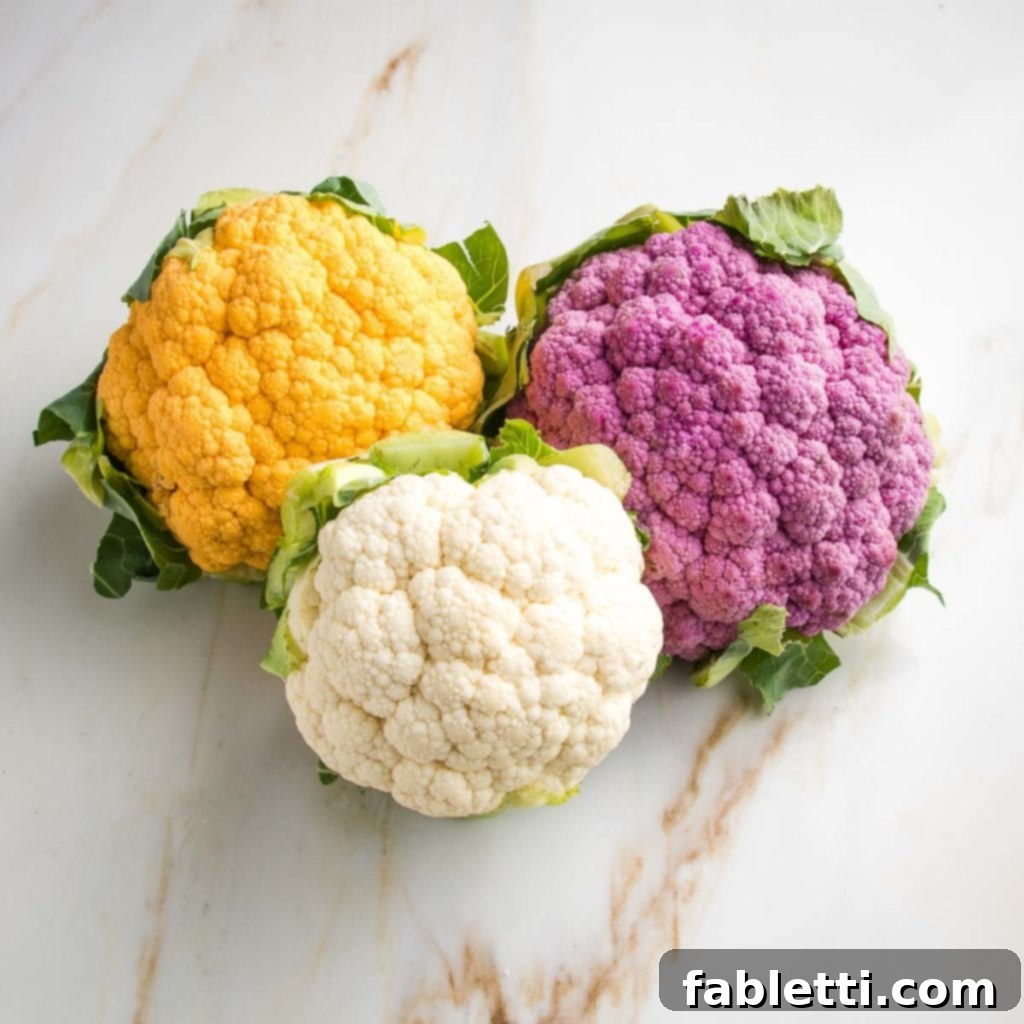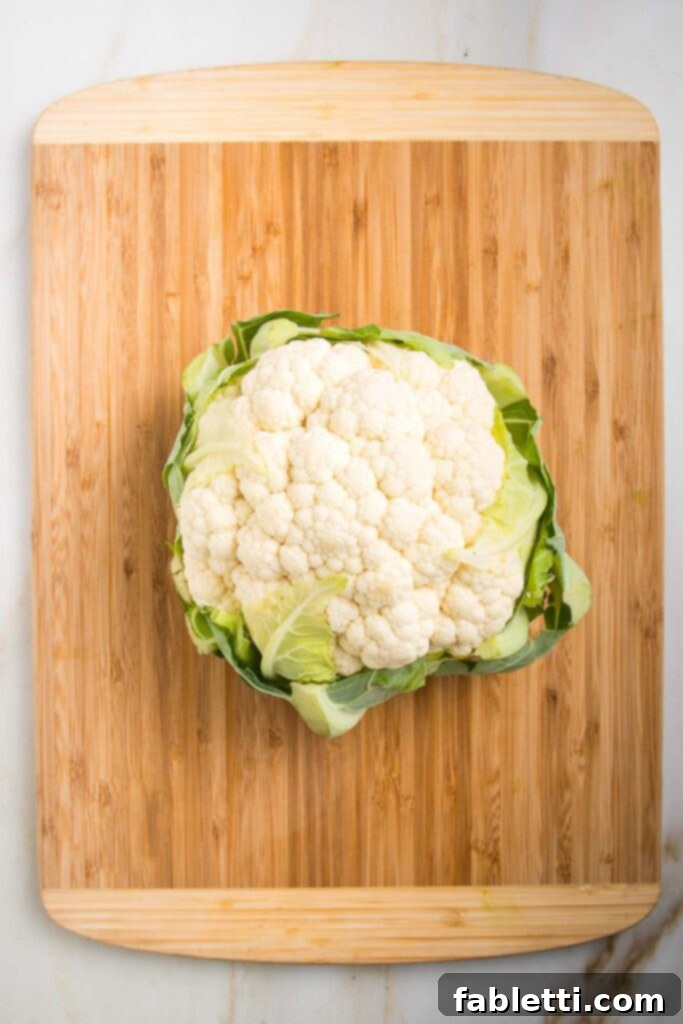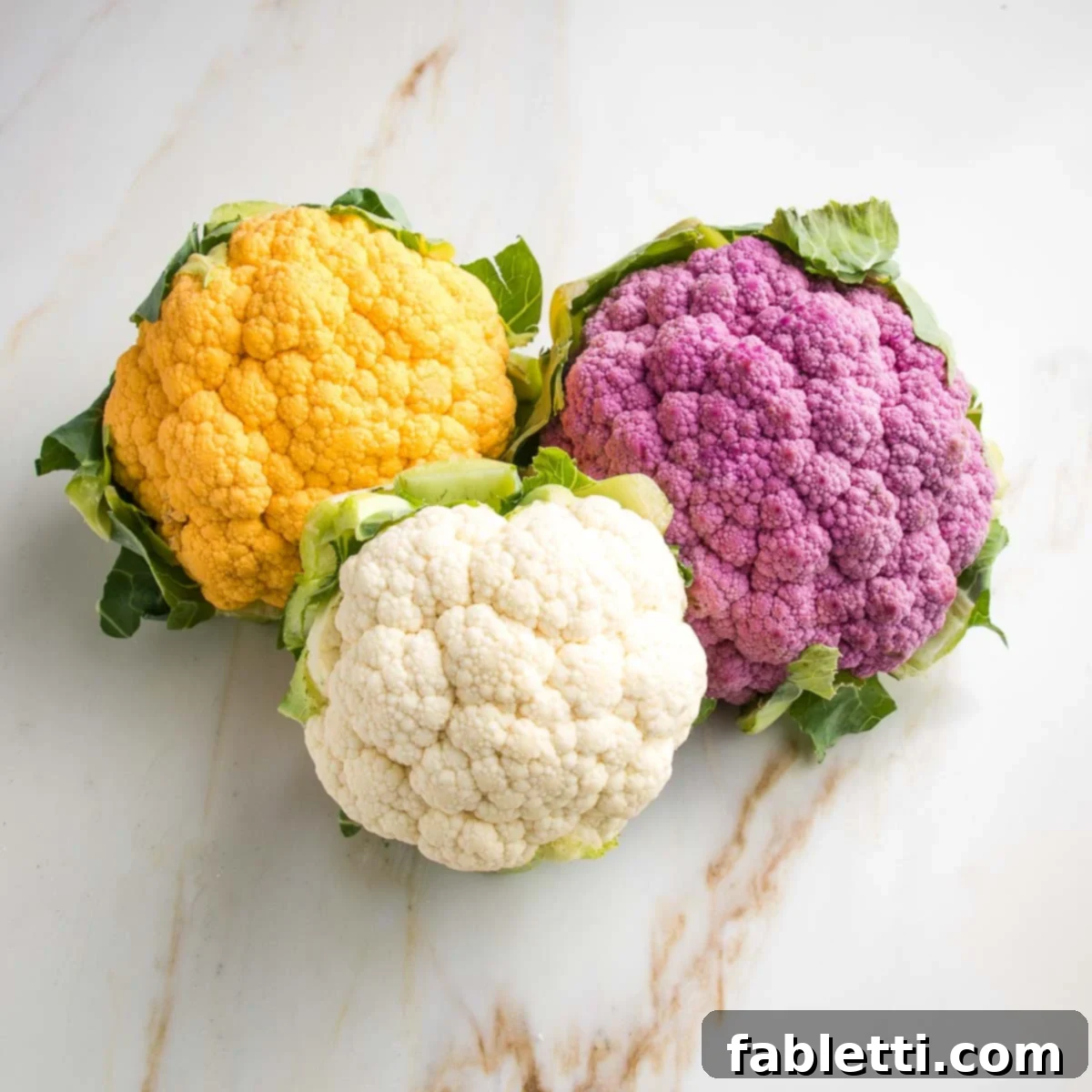Cauliflower, a true culinary marvel, is celebrated for its dense nutrition, incredible versatility, and remarkable ability to transform into countless delicious dishes. Whether you’re a seasoned chef or just beginning your plant-based journey, this humble cruciferous vegetable offers an exciting world of flavor and health benefits. But what truly makes a cauliflower dish sing? The secret often lies in knowing what to serve alongside it. Dive into this comprehensive guide for my tastiest ideas on what to serve with cauliflower, along with some of my best cauliflower recipes that are sure to become family favorites.
Consider this your ultimate resource for embracing cauliflower’s full potential. From easy weeknight solutions to impressive holiday centerpieces, you’ll discover innovative ways to incorporate this healthy vegetable into your diet, enhancing both flavor and nutrition.

This post may contain affiliate links. As an Amazon Associate, I earn from qualifying purchases at no additional cost to you.
Cauliflower truly embodies the spirit of a culinary chameleon, effortlessly adapting to the flavors and textures you desire. Its inherently mild taste makes it a blank canvas, ready to absorb whatever spices and essences you introduce. This remarkable characteristic allows cauliflower to shine in a vast array of cuisines and preparation styles, making it an undeniable crowd-pleaser for any palate.
Whether your goal is a hearty main course, a delightful side dish, or a simple, quick recipe, cauliflower’s adaptability ensures that a satisfying meal is always within reach. It’s perfect for transforming into a comforting weeknight dinner or an elegant, nutrient-dense option for special occasions and holiday gatherings. Moreover, cauliflower is equally delicious prepared raw or cooked, offering a spectrum of textures and tastes. Exploring various cooking techniques will unlock the best results for this incredibly versatile vegetable.
How to Buy and Store Cauliflower for Maximum Freshness

Selecting and storing cauliflower properly is key to enjoying its best flavor and texture. Here’s how to ensure you get the freshest head and keep it that way:
- Source Locally: Fresh cauliflower can be found at local farmers’ markets, grocery stores, and larger retail outlets. Opt for local produce when possible for peak freshness.
- Look for Densely Packed Florets: The ideal head of cauliflower will have florets that are tightly clustered and feel firm to the touch. Avoid any heads with gaps or loose sections.
- Inspect for Blemishes: Choose cauliflower that is free from any brown spots, wet areas, or discoloration. These are signs of spoilage.
- Check the Leaves: The attached green leaves should be vibrant, fresh, and crisp. Wilted or yellowing leaves indicate that the cauliflower is past its prime and has lost some of its moisture and nutrients.
- Proper Storage: Store a whole head of cauliflower in an unsealed plastic bag in your refrigerator’s vegetable drawer. To absorb any excess moisture and prevent sogginess, insert a paper towel into the bag. This method helps keep it fresh for up to two weeks.
- Pre-cut Florets: If buying pre-cut florets, ensure they are bright white and firm, stored in a sealed container, and use within a few days.
If you’re looking for incredibly healthy cauliflower dishes that burst with flavor, you’ve certainly come to the right place. An easy cauliflower rice with asparagus recipe could be the perfect light and satisfying side dish you’ve been searching for. For a truly impressive and nourishing main course, consider the vegan elegance of a whole roasted cauliflower – it’s surprisingly simple to prepare and visually stunning.
Perhaps your main query is simply what to serve with cauliflower to create a balanced and delicious meal? I have an abundance of fantastic ideas for you! A rich and savory vegan mushroom stroganoff would be absolutely fabulous served over a light and fluffy simple cauliflower rice, offering a comforting and wholesome combination. For dinner, make a nutrient-dense vegan shepherd’s pie and complement it with a fresh and zesty roasted cauliflower salad. The pairing possibilities with cauliflower are truly endless; keep reading, and you’re sure to discover the perfect match for your next meal.
Top Health Benefits of Cauliflower: Why It’s a Superfood
Cauliflower isn’t just versatile; it’s a powerhouse of nutrition, offering a wide array of health benefits that make it an invaluable addition to any diet. Here’s a closer look at what makes this cruciferous vegetable so good for you:
- Rich in Fiber: Cauliflower is an excellent source of dietary fiber, crucial for digestive health. Fiber helps maintain regular bowel movements, preventing constipation and promoting a healthy gut microbiome. The beneficial bacteria in your gut thrive on fiber, which in turn reduces inflammation, supports a strong immune system, and lowers your risk for various diseases.
- Packed with Vitamins: This humble vegetable is remarkably high in Vitamin C, an essential antioxidant that boosts immunity and promotes collagen production for healthy skin. It also provides significant amounts of Vitamin K, vital for blood clotting and bone health, and several B vitamins, including B6 and folate, which are important for energy metabolism and cell function.
- Abundant in Minerals: Beyond vitamins, cauliflower offers a good supply of essential minerals like potassium, which helps regulate blood pressure and fluid balance, and magnesium, important for muscle and nerve function, blood sugar control, and bone strength.
- Potent Phytochemicals: As a member of the cabbage family (Brassicaceae), cauliflower contains unique plant compounds called glucosinolates and isothiocyanates. These phytochemicals are extensively studied for their protective effects, including detoxification support and potential anti-cancer properties.
- Powerful Antioxidants: Cauliflower is rich in various antioxidants, most notably sulforaphane. These compounds combat oxidative stress and inflammation throughout the body, providing robust protection against chronic diseases and enhancing overall immune function.
- Low in Calories & Nutrient Dense: With a high water content (over 90%) and very few calories, cauliflower is an ideal food for weight management. It helps you feel full and satisfied without consuming excessive calories, making it a smart choice for those looking to maintain a healthy weight.
- Low in Carbohydrates: True to its “chameleon” nature, cauliflower is exceptionally low in carbohydrates, making it a star ingredient for keto, paleo, and low-carb diets. It can effectively substitute for higher-carb grains and legumes in recipes, helping to manage blood sugar levels and support metabolic health.
Incorporating cauliflower into your meals means you’re not just enjoying delicious food, but also actively nurturing your health with every bite.
Cauliflower Rice: A Low-Carb, Gluten-Free Alternative
Cauliflower rice has revolutionized healthy eating, offering a fantastic low-carb, gluten-free, and nutrient-dense alternative to traditional rice and other grains. Its neutral flavor makes it incredibly versatile, ready to adopt the profile of any dish you’re creating. The easiest way to make cauliflower rice at home is by using a food processor. Simply use the “S” blade to pulse cauliflower florets into grain-like bits, or utilize the shredding disc for a slightly different texture. If you don’t have a food processor, a simple box grater can achieve similar results, transforming cauliflower into a delicious and healthy rice substitute.
Frozen Cauliflower Rice: Convenience at Your Fingertips
For ultimate convenience, pre-riced cauliflower can be found in the freezer section of most grocery stores. Frozen cauliflower rice is a superb option for those without a food processor or for busy individuals who want to save prep time. It can be used straight from the freezer in any cauliflower rice recipe, making healthy meal prep a breeze. With a freezer life of up to three months, keeping a bag or two on hand ensures you’re always prepared to whip up a nutritious and quick meal.
How to Make Fresh Cauliflower Rice at Home
Making your own cauliflower rice is simple and gives you full control over the texture. Follow these steps for perfect results:
- Prepare the Cauliflower: Start by cutting the whole head of cauliflower in half, right through its core.
- Trim and Segment: Trim off the tough bottom stem and any remaining green leaves. Break the cauliflower into smaller florets that are manageable for your food processor or grater.
- Process in Batches: Place the cauliflower florets into the bowl of your food processor. It’s crucial not to overcrowd the machine; work in batches if necessary to ensure even processing.
- Pulse to Rice Consistency: Pulse the cauliflower for about 20 seconds. Scrape down the sides of the bowl to ensure all pieces are processed evenly. Continue pulsing until you achieve a texture that resembles grains of rice. Be careful not to over-process, or it will turn into a mushy paste.
- Cooking Tip: Once riced, you can sauté it in a pan with a little olive oil and your favorite seasonings until tender-crisp for a delicious side dish.
Choosing the Best Food Processor for Cauliflower Rice
The “best” food processor for cauliflower rice is often the one you already own! Most standard food processors can handle the task effectively. I personally love my Breville Food Processor, and if you’re in the market for a new one, I highly recommend it for its power and efficiency.
Regardless of your model, you can achieve excellent results by avoiding overcrowding the bowl. Process small amounts of florets at a time, performing several batches if needed. Alternatively, you can use the shredding disc attachment. Roughly chop the cauliflower into pieces that fit through the feeding chute, and let the disc do the work. The Breville Food Processor is particularly great for this method, thanks to its wide feeding tube that minimizes pre-chopping.
How to Tell if Cauliflower Rice Has Gone Bad
Knowing the signs of spoiled cauliflower rice is important for food safety. The first and most obvious clue that cauliflower rice has gone bad will be its odor. Fresh cauliflower rice has a mild, almost undetectable scent, while spoiled cauliflower rice will emit a sour or foul, unpleasant smell. Furthermore, if you observe any mold growth, discolored brown spots, or if the texture has become rubbery or mushy, it’s best to discard it immediately. Never consume cauliflower with any signs of decay or spoilage.
Delicious Cauliflower Rice Recipes
Cauliflower rice is an incredibly versatile ingredient, offering a low-carb and gluten-free base for a myriad of flavorful dishes. Explore these tempting recipes:
1. Cauliflower Rice with Asparagus
Cauliflower Rice with Asparagus
Cauliflower Rice with Asparagus
2. Gluten-free Tabbouleh with Cauliflower Rice
Gluten-free Tabbouleh with Cauliflower Rice
Tabbouleh with Cauli-Rice
3. Mediterranean Cauliflower Rice
Mediterranean Cauliflower Rice
Mediterranean Cauliflower Rice
4. Vegan Stuffed Portobello Mushrooms
Vegan Stuffed Portobello Mushrooms
Vegan Stuffed Portobello Mushrooms
5. Simple Cauliflower Rice
Simple Cauliflower Rice
Herbed Cauliflower Rice Recipe
6. Oven Baked Mexican Cauliflower Rice
Oven Baked Mexican Cauliflower Rice
Mexican Oven Baked Cauliflower Rice
How to Cut a Whole Cauliflower into Perfect Florets
Transforming a whole head of cauliflower into perfectly sized florets is a fundamental skill for many recipes. You’ll need a sharp knife and a sturdy wooden cutting board to make this task easy and safe.

- Cut in Half: Place the cauliflower stem-side down on your cutting board. Carefully cut the cauliflower in half right down the center, through the core.
- Trim the Leaves and Core: Take one half and lay it flat. Trim off the bottom core and any remaining tough green leaves. Repeat with the second half.
- Segment into “Trees”: With one half of the cauliflower facing up, use your knife to follow the natural divisions of the florets. Cut them into small, tree-like pieces. Aim for florets that are roughly uniform in size to ensure even cooking.
- Continue Until Complete: Keep cutting until both halves have been transformed into small, bite-sized florets. These are now ready for your chosen preparation method! For roasted cauliflower, simply spread them on a sheet pan, drizzle with olive oil, and sprinkle with your favorite spices.
What to Serve with Cauliflower: Perfect Pairings for Every Meal
I always make sure to have a head of cauliflower in my fridge because its incredible versatility means I can use it in a myriad of ways, opening up endless possibilities for delicious meal pairings. Here are some of my favorite combinations:
- A comforting vegan meatloaf finds its perfect match with creamy mashed cauliflower, offering a rich yet lighter alternative to traditional mashed potatoes.
- For a hearty and complete one-bowl vegan meal, serve Dijon Lentils with Roasted Veggies alongside a generous portion of roasted cauliflower, creating a satisfying and nutrient-packed dish.
- Homemade roasted cauliflower hummus is a fantastic dip that’s best enjoyed with fresh crudités or as a creamy spread for sandwiches and wraps. Take it to the next level by spreading a generous shmear on a quinoa veggie burger or a black bean burger – next-level yum, I promise!
- Elevate your breakfast or snack time by making a batch of chia jam to go with savory cauliflower onion rolls, creating a unique sweet and savory experience.
- If you’ve prepared a magnificent whole roasted cauliflower as a centerpiece, a crisp and simple green salad is all you need to perfectly balance the meal.
- I adore this gorgeous raw cauliflower salad because it truly stands on its own as a refreshing dish, and also pairs beautifully with a chilled gazpacho.
- A robust Spiced Chickpea Stew + Veggies is a complete and utterly satisfying meal on its own, but why not indulge afterwards with some delightful tahini brownies? You’re welcome!
Creamy and Flavorful Vegan Cauliflower Soup Recipes
Cauliflower is a secret weapon for creating luxuriously creamy and savory soups without a drop of dairy. Its mild flavor enhances the overall taste profile without overpowering other ingredients. Beyond its delicious contribution, cauliflower serves as a whole foods ingredient that naturally thickens soups, making it a healthy and wholesome choice for adding body and texture.
7. Cauliflower Soup with Red Lentils
Cauliflower Soup with Red Lentils
Cauliflower Soup with Red Lentils
8. Creamy Vegan Asparagus Soup
Creamy Vegan Asparagus Soup
Vegan Asparagus Soup Recipe
9. Chunky Roasted Veggie Soup
Chunky Roasted Veggie Soup
Chunky Roasted Veggie Soup Recipe
Cauliflower FAQs: Your Top Questions Answered
Cauliflower is a highly nutritious cruciferous vegetable belonging to the mustard family. It’s closely related to broccoli, cabbage, and kale. While typically known for its white head, it also comes in vibrant purple, green, and orange varieties. Each part of the cauliflower, from its tender florets to its stem, can be enjoyed, making it incredibly easy to incorporate into your diet. Cauliflower can be prepared in numerous ways: eaten raw, steamed, roasted, pureed into creamy sauces, mashed as a potato substitute, or riced into grain-like bits. Its versatility allows it to seamlessly integrate into soups and stews for thickening, salads for added texture, or roasted whole as an impressive vegan centerpiece meal.
A fresh, whole head of cauliflower, when stored properly in an unsealed plastic bag (perhaps with a paper towel to absorb moisture) in the refrigerator, can last for 1 to 2 weeks. Once cut or processed, cauliflower’s shelf life significantly shortens. Cauliflower rice, for instance, will typically last for 3 to 5 days in the fridge when stored in an airtight container. For longer storage, cauliflower rice can be placed in a freezer-safe container and kept in the freezer for up to 2 months.
Absolutely, yes! Raw cauliflower is crunchy, refreshing, and delicious, offering a slightly peppery flavor. It can be a wonderful addition to your diet. Enjoy raw cauliflower as part of a vibrant crudités platter, served with a healthy dip like green tahini sauce. Alternatively, cauliflower can be finely chopped or shaved and enjoyed as a key ingredient in a raw cauliflower salad, adding a delightful crunch and boost of nutrients.
More Healthy and Delicious Cauliflower Recipes
Beyond rice and soups, cauliflower continues to impress with its adaptability in a variety of other healthy and flavorful dishes:
10. Whole Roasted Cauliflower
Whole Roasted Cauliflower
Whole Roasted Cauliflower Recipe
11. Roasted Cauliflower Shawarma
Roasted Cauliflower Shawarma
Roasted Cauliflower Shawarma Recipe
12. Roasted Cauliflower Salad Recipe
Roasted Cauliflower Salad Recipe
Roasted Cauliflower Salad Recipe
13. Vegan Cauliflower Steak with Chimichurri Sauce
Vegan Cauliflower Steak with Chimichurri Sauce
Cauliflower Steaks with Chimichurri
14. Roasted Cauliflower Hummus
Roasted Cauliflower Hummus
Low Carb Roasted Cauliflower Hummus
15. Cauliflower Kugel
Cauliflower Kugel
Cauliflower Kugel Recipe
📖 Easy Roasted Cauliflower Recipe

Easy Roasted Cauliflower Recipe
Debra Klein
Pin Recipe
5
25
30
Side Dish
American
4 servings
95 kcal
Equipment
- 13-piece Measuring Cups and Spoons Set, 18/8 Stainless Steel Heavy Duty Ergonomic Handle with Ring Connector
- PRECISE CANADA: STAINLESS STEEL HEAVY BAKING SHEET
- OXO Good Grips 12-Inch Stainless-Steel Locking Tongs
Ingredients
- 1 head cauliflower approximately 4 cups florets
- 2 Tablespoons olive oil
- ½ teaspoon coarse sea salt
- ½ teaspoon turmeric
- ½ teaspoon cumin
- ½ teaspoon paprika
- ¼ teaspoon ground black pepper
Instructions
- Preheat your oven to 425°F (220°C).
- PREPARE CAULIFLOWER: First, cut the cauliflower head in half down through the core. Then, trim off the leaves and the tough bottom core. Proceed to cut the cauliflower into even-sized florets.
- WASH CAULIFLOWER: Place the florets into a bowl of lightly salted water. Let them soak for about a minute; this helps dislodge any small impurities or bugs. Drain the cauliflower thoroughly and spread the florets on a clean kitchen towel to dry completely. Excess moisture will prevent proper roasting.
- Spread the dried cauliflower florets onto a rimmed baking tray, ensuring they fit in a single layer without overcrowding. If needed, use two baking trays to ensure even roasting rather than steaming.
- Drizzle the cauliflower with olive oil. Use your hands or a large pair of tongs to mix well, ensuring the oil is evenly distributed over all the florets. Sprinkle on the coarse sea salt, turmeric, cumin, paprika, and ground black pepper, then mix thoroughly again until all the florets are coated with the spices.
- Roast in the preheated oven for 20 minutes, or until the edges are lightly crisp and golden brown, and the inside is tender when pierced with a fork. Serve immediately and enjoy your perfectly roasted cauliflower!
Notes
Nutrition
Calories: 95kcal
Carbohydrates: 6g
Protein: 3g
Fat: 7g
Saturated Fat: 1g
Polyunsaturated Fat: 6g
Sodium: 286mg
Fiber: 3g
Sugar: 3g
Note
The nutrition calculations were done using online tools and are approximate. To obtain the most accurate representation of the nutritional information in any given recipe, you should calculate the nutritional information with the actual ingredients you used. You are ultimately responsible for ensuring that any nutritional information is accurate, complete, and useful.
Did you make this recipe?
Please leave a review below, then snap a picture and tag me @dkhealthcoach or use hashtag #dkhealtcoach on Instagram so I can see it!!
